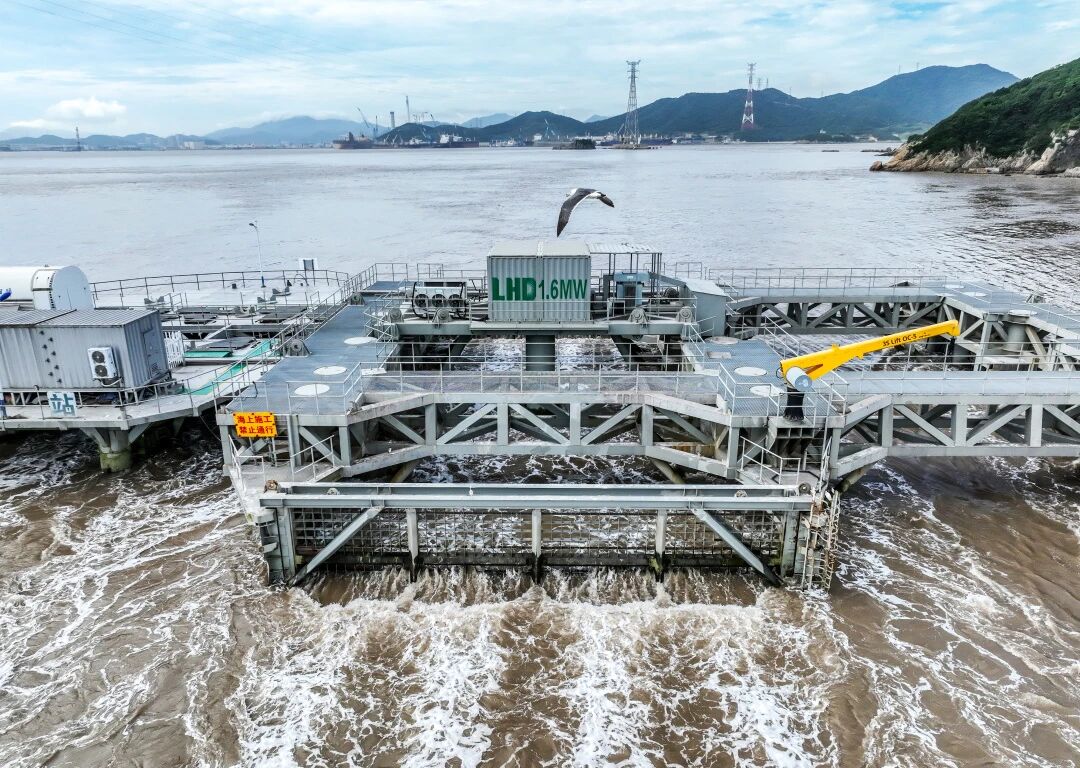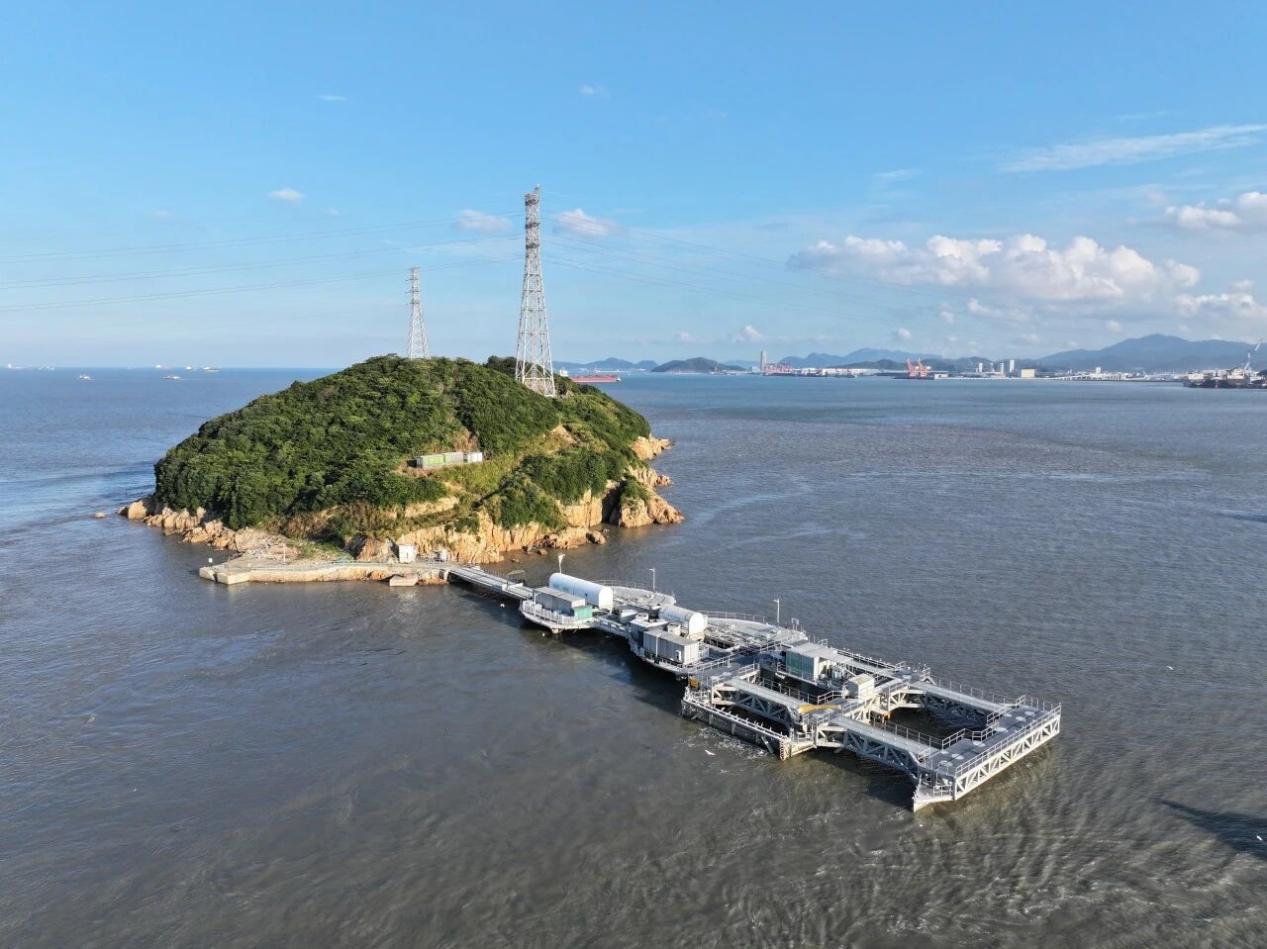Zhoushan?in E China?harnesses?ocean power for a sustainable future

A bird flies over a unit of the LHD Zhoushan tidal current power station.
In the waters off Xiushan Island, Daishan county, Zhoushan, east China's Zhejiang province, a striking "violin"-shaped platform rises above the waves. Beneath it, powerful tidal currents flow through turbines, converting the ocean's kinetic energy into clean electricity.
This is the LHD Zhoushan tidal current power station, China's first independently developed megawatt-level tidal current power generator. It has operated stably for years and ranks among the world's longest-running tidal energy systems with continuous grid connection.
Just minutes by speedboat from Xiushan Island's southeastern pier, the platform measures approximately 200 meters in length, 35 meters in width, and 30 meters in height. Secured above the churning sea, the platform houses turbines that harness tidal currents and transmit the electricity directly to the national grid.
Tidal energy utilizes the movement of seawater caused by tidal shifts to generate power. With over 400 islands and expansive coastal waters, Daishan county, located in the Zhoushan Islands, is naturally suited for this technology. Its waterways, straits, and bays produce fast, concentrated currents, an ideal environment for harnessing marine energy.
"This is an ideal site for tidal power generation," said Lin Dong, director of Zhejiang LHD Ocean Tidal Current Energy Engineering Research Center. He likened tidal energy to wind power, as both convert fluid movement into electricity. However, seawater's higher density means tidal power can generate significantly more energy than wind at the same speed.
"In simple terms, it's like placing a giant windmill under the sea," Lin explained. The platform's foundation is anchored securely to the seabed with rock-socketed piles, enabling the turbines to spin reliably as tides pass, powering the generators above.
Despite the promising energy output, the harsh marine environment presents maintenance challenges. Corrosive saltwater and powerful currents make traditional seabed-mounted systems difficult and costly to manage.
To overcome these obstacles, Lin and his team adopted a platform-based and modular design approach. Key system components are divided into independent modules that can function separately, and the above-water platform enables easier upgrades and maintenance without halting operations.
"Traditional large generators sit directly on the seabed and are fully submerged," Lin noted. "Our design places critical components above the waterline. If one module needs repair or expansion, we can isolate and service it with minimal disruption."
Inside the LHD United Kinetic Marine Energy laboratory, a large monitoring screen displays real-time footage of the station's power generation. The turbine blades, designed for durability and efficiency, are supported by a proprietary pitch-control system that adjusts their angle based on water flow. Notably, the blades automatically reverse with the tides, allowing for bidirectional energy capture.
By the end of October this year, the LHD tidal energy project had generated over 8.34 million kilowatt-hours of electricity. Its single-unit capacity and duration of continuous operation rank among the highest in the world, equivalent to saving 2,359 tons of standard coal and contributing effectively to China's dual carbon goals. Lin estimated that the cost of tidal energy generation is expected to drop below 0.3 yuan ($0.042) per kilowatt-hour upon completion of the seventh-generation LHD unit.
In September, a 100-megawatt tidal energy project jointly invested by the Zhejiang company of State Power Investment Corporation and Hangzhou LHD New Energy Technology Co., Ltd. officially broke ground in Zhoushan.
Supporting projects are also advancing steadily. According to plans from the Zhoushan Development and Reform Commission, an 800-mu (53.3 hectares) marine tidal energy industrial park is set to rise in the western area of Xiushan Island. The park will feature equipment manufacturing facilities, an industrial technology innovation institute, a testing and certification center, and an international exhibition center for tidal energy. With ocean tidal energy at its core, a comprehensive industrial ecosystem is already taking shape.

Photo shows the LHD Zhoushan tidal current power station.
(Photos provided by the interviewee)
Photos
 Int'l delegation explores organic tea culture in Baisha, S China's Hainan
Int'l delegation explores organic tea culture in Baisha, S China's Hainan Chamber Concert of Chinese Classical Music held at China Cultural Center in Kuwait
Chamber Concert of Chinese Classical Music held at China Cultural Center in Kuwait 27th Harbin Ice-Snow World to officially begin construction in NE China
27th Harbin Ice-Snow World to officially begin construction in NE China Promotion week for intangible cultural heritage brands opens in Dali, China's Yunnan
Promotion week for intangible cultural heritage brands opens in Dali, China's Yunnan
Related Stories
- Traditional crafts drive rural revitalization in Yongkang, E China's Zhejiang
- Citrus fruits enter harvest season in China's Zhejiang
- Zhejiang drives economic prosperity through flourishing cultural development
- Internet life carnival kicks off in Tongxiang City, China's Zhejiang
- 100 years of health | Passion outlasts time: Three centenarians' secret
- Shuanglin Three Bridges: a pathway home for generations
- Osmanthus flowers enter blooming period in Hangzhou, China's Zhejiang
- Pearls and socks: East China city's dual global triumphs
- Quzhou in E China promotes Chinese etiquette education to foster harmonious living environment
- Reapers harvest paddy rice in town of Jinhua, China's Zhejiang
Copyright © 2025 People's Daily Online. All Rights Reserved.





